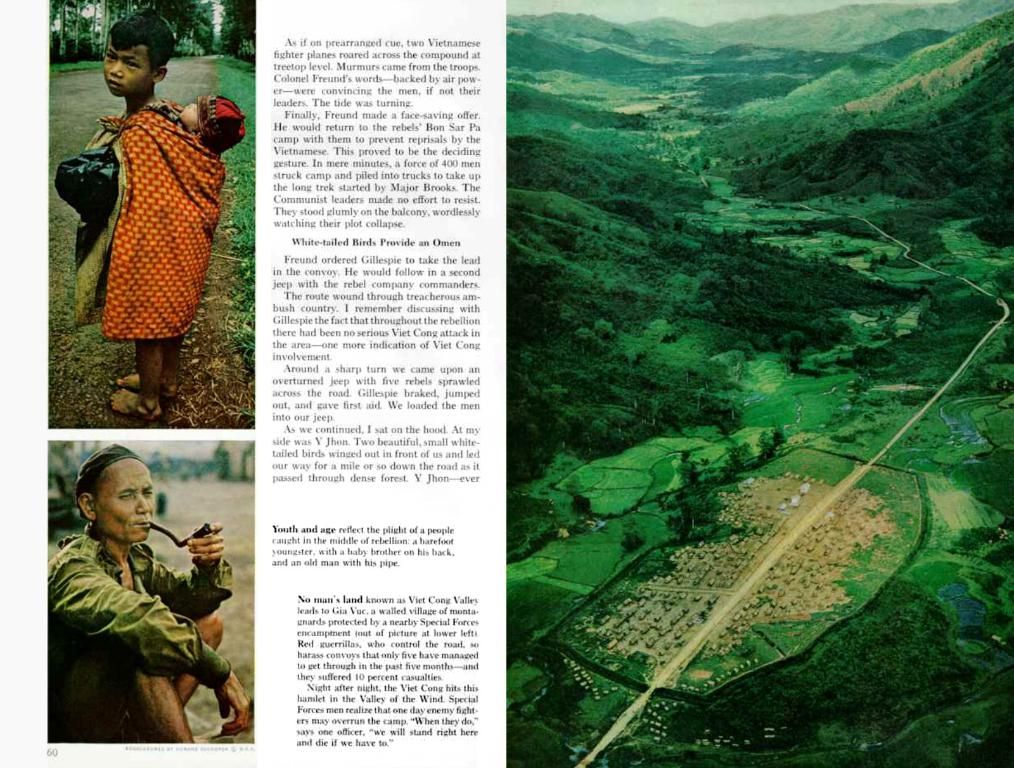Business Intelligence from Satellite Data: Leveraging Cutting-edge Aerial Photographs for Corporate Decision-Making
Revamped Take on Harnessing the Power of Satellite Technology for Business Decisions
In the past, businesses relied on historical data, intuition, or outdated reports for making decisions. But in today's rapidly evolving world, speed and accuracy are everything. That's where satellite technology comes in. With clearer, more frequent, and easily accessible satellite imagery, businesses can finally gain a direct, real-time view of the world.
What was once the exclusive domain of governments and extensive research institutions is now accessible to logistics companies, agribusinesses, financial analysts, and even municipalities. And this is more than just pictures — the real revolution is in how businesses are using the latest satellite imagery in conjunction with intelligent tools to generate insights, take action, and inform strategy.
Satellite Imagery and Ingenious Analytics
Today's satellite images are a far cry from the grainy, black-and-white images of yore. Modern satellites capture ultra-high-resolution imagery across multiple spectral bands, including visible, infrared, and thermal. This means that the data goes beyond what the human eye can see. You're not just examining a city, a forest, or a coastline — you're seeing how it lives, grows, and transforms over time.
For businesses, that's gold. Farmers can spot crop stress days before it becomes visible from the ground. Retailers can track foot traffic or parking lot activity across multiple stores. Mining firms can keep tabs on unauthorized activities on leased land. A reliable satellite monitoring platform serves as both an early warning system and a long-term strategic tool.
The top platforms don't just deliver raw images. They offer tools to compare timelines, overlay different data types, and even incorporate external datasets like weather, soil moisture, or economic indicators. And thanks to user-friendly interfaces, individuals without a background in geospatial analysis can easily navigate the technology.
While some companies opt for specialized services to purchase satellite images for custom analysis, others are profiting from open-source satellite imagery available for free. Depending on your use case, whether it's daily monitoring or historical comparison, the optimal tool and data combination can deliver meaningful business insights at a fraction of traditional monitoring costs.
Applications of Satellite-Powered Business Analytics
The variety of industries using satellite-based analytics is growing every year. In agriculture, satellite data helps track planting progress, estimate yields, and optimize irrigation. For supply chain and infrastructure management, satellite monitoring can detect bottlenecks (not based on estimates, but through visual proof) from above.
In the financial sector, hedge funds and investors are using commercial satellite imagery to assess port activity, oil storage levels, or mining operations. The construction industry benefits from being able to verify progress at sites (even remote ones) without setting foot on the ground. And environmental organizations use satellite pictures to track coastline erosion or illegal development near protected areas.
What all these applications share is the ability to make smarter, faster decisions based on reality, not assumptions. And when those decisions involve significant investments or public impact, the stakes couldn't be higher.
Transforming Images into Intelligence
Of course, a satellite image alone doesn't tell the whole story. The true value lies in what you can extract from it and how swiftly. That's why today's most effective platforms integrate satellite images of Earth with artificial intelligence, machine learning, and geospatial analysis. These technologies process vast amounts of data in minutes, detecting patterns and changes that no human could discern manually.
For example, AI can compare images over time and automatically flag situations where forest loss has occurred, where new buildings have been constructed, or where floodwaters have spread. In agriculture, it can highlight subtle shifts in vegetation that may indicate pest outbreaks or drought stress. This level of monitoring saves time and makes it possible to act before a problem becomes a disaster.
Dashboards, maps, and business intelligence integrations turn these findings into something actionable. A logistics manager doesn't need to pore over pixels — they need to know which port is facing unexpected congestion. A farm advisor doesn't need to decipher NDVI charts — they need to tell their client which field requires immediate attention. By connecting satellite data with tailored analytics, businesses move from being reactive to proactive. They don't just respond faster but plan better too.
In an era where every advantage counts, satellite imagery of Earth has emerged from a niche tool to a business necessity. It sheds light on inaccessible areas, offers a perspective that no drone or ground survey can match, and turns passive observation into active strategy. Whether through daily satellite imagery, historical comparisons, or predictive modeling, the technology is empowering decision-makers like never before.
Written by:
Vasyl Cherlinka
With 30 years of experience in the field, Vasyl Cherlinka is a Doctor of Biosciences specializing in pedology (soil science). Having earned degrees in agrochemistry, agronomy, and soil science, Dr. Cherlinka has been advising the private sector on these issues for many years.
- In the agriculture industry, satellite data is utilized to track planting progress, estimate yields, and optimize irrigation, providing farmers with valuable business insights.
- The construction industry benefits from being able to verify progress at remote sites without needing to physically visit, thanks to satellite-based monitoring.
- In the financial sector, commercial satellite imagery is employed by hedge funds and investors to assess activities like port activity, oil storage levels, or mining operations, aiding informed decision-making.
- For logistics managers, dashboards, maps, and business intelligence integrations derived from satellite imagery enable them to quickly identify congested ports and take proactive measures.
- By combining satellite images with artificial intelligence, machine learning, and geospatial analysis, businesses can swiftly extract valuable patterns and changes, transforming passive observation into active strategy in the aerospace, finance, and various other industries.




